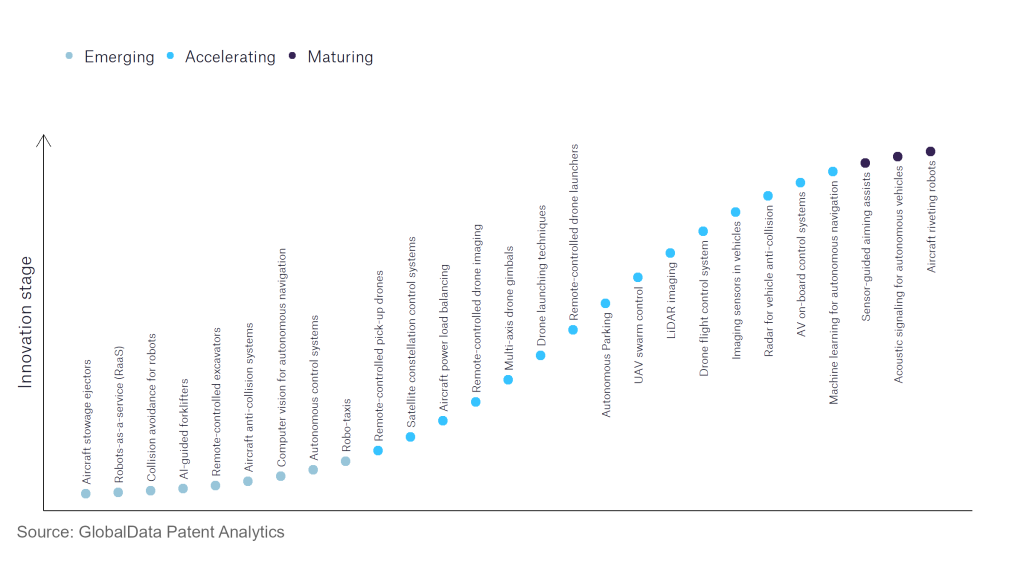The aerospace and defence industry continues to be a hotbed of innovation, with the conflict in Ukraine driving defence spending and investment, the need to combat emerging technologies such as hypersonics, and growing importance of technologies such as AI and computer vision. In the last three years alone, there have been over 174,000 patents filed and granted in the aerospace and defence industry, according to GlobalData’s report on Robotics in Aerospace, Defence & Security: LiDAR imaging. Buy the report here.
However, not all innovations are equal and nor do they follow a constant upward trend. Instead, their evolution takes the form of an S-shaped curve that reflects their typical lifecycle from early emergence to accelerating adoption, before finally stabilising and reaching maturity.
Identifying where a particular innovation is on this journey, especially those that are in the emerging and accelerating stages, is essential for understanding their current level of adoption and the likely future trajectory and impact they will have.
180+ innovations will shape the aerospace and defence industry
According to GlobalData’s Technology Foresights, which plots the S-curve for the aerospace and defence industry using innovation intensity models built on over 262,000 patents, there are 180+ innovation areas that will shape the future of the industry.
Within the emerging innovation stage, collision avoidance for robots, computer vision for autonomous navigation, and autonomous control systems are disruptive technologies that are in the early stages of application and should be tracked closely. UAV swarm control, and drone flight control system are some of the accelerating innovation areas, where adoption has been steadily increasing. Among maturing innovation areas are sensor-guided aiming assists and which are now well established in the industry.
Innovation S-curve for robotics in the aerospace and defence industry

LiDAR imaging is a key innovation area in robotics
LiDAR, which stands for Light Detection and Ranging, is a sensing method that uses light in the form of a pulsed laser to measure ranges.
GlobalData’s analysis also uncovers the companies at the forefront of each innovation area and assesses the potential reach and impact of their patenting activity across different applications and geographies. According to GlobalData, there are 40 companies, spanning technology vendors, established aerospace and defence companies, and up-and-coming start-ups engaged in the development and application of LiDAR imaging.
Key players in LiDAR imaging – a disruptive innovation in the aerospace and defence industry
‘Application diversity’ measures the number of different applications identified for each relevant patent and broadly splits companies into either ‘niche’ or ‘diversified’ innovators.
‘Geographic reach’ refers to the number of different countries each relevant patent is registered in and reflects the breadth of geographic application intended, ranging from ‘global’ to ‘local’.
Patent volumes related to LiDAR imaging
Source: GlobalData Patent Analytics
Faro technologies is one of the leading patent filers in LiDAR imaging. The company produces LiDAR solutions including laser measurements for construction and measurement which can be integrated into mobile robots where necessary. The company has also made acquisitions including GeoSLAM in order to further its imaging solutions. It is a leading company in laser scanning and the numerous patent filings are to solidify and advance its market position. Another leading company in the sector is Sony Group which has patent solutions for automotive Lidar, to produce precise distance measurement.
LeddarTech is a leading patent filer in terms of application diversity, producing technology which supports a number of industries including manufacturing, construction and the automotive sector. The company’s technology has been integrated into commercial vehicles as well as industrial and off-road vehicles. Another leader in terms of application diversity is Seescan which provides LiDAR solutions for underground and undersea mapping.
Semiconductor Energy Laboratory is a leading company in terms of geographic diversity, the company produces LiDAR solutions for R&D. Also significant in terms of geographic diversity is MagikEye which produces LiDAR solutions for a number of sectors including healthcare, commercial drones and automotives.
To further understand the key themes and technologies disrupting the aerospace and defence industry, access GlobalData’s latest thematic research report on Defence.
Data Insights
From

The gold standard of business intelligence.
Blending expert knowledge with cutting-edge technology, GlobalData’s unrivalled proprietary data will enable you to decode what’s happening in your market. You can make better informed decisions and gain a future-proof advantage over your competitors.



